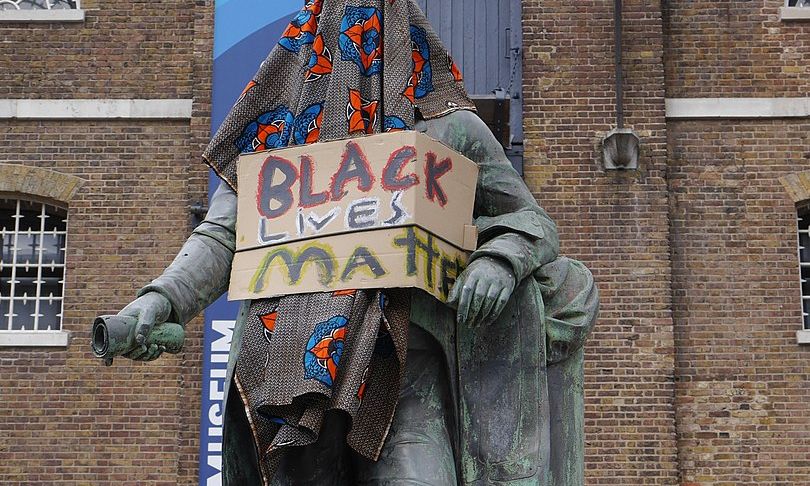The statue of slaver Robert Milligan was removed from its place at the London Docklands in 2020
Chris McKenna via Wikimedia Commons
More than two years after the Conservative government announced a strategy to “retain and explain” controversial monuments and historic statues, the UK culture sector finally received the relevant guidance yesterday from the Department for Digital, Culture, Media and Sport (DCMS).
The document, written by a seven-member heritage advisory board, outlines steps that should be taken by custodians of contentious public memorials (statues, monuments and commemorations). Board members include the former director of the Equality and Human Rights Commission Trevor Phillips, the historian Robert Tombs and Anna Keay, the director of the Landmark Trust.
“This toolkit is intended to ensure that heritage decision-makers can access expert advice and good practice to support them to make better and more considered decisions with confidence when deciding how to deal with a heritage asset which may have become the focus of debate,” a DCMS statement says. The guidance does not cover heritage assets outside England or museums’ and galleries’ collections.
Yesterday (October 5), the historian David Olusoga told BBC’s Radio 4 Today programme that he has a “problem” with the new government guidance because it “regurgitates two falsehoods…the first is that the problem with statues is modern attitudes [are] changing, which implies people approved of these statues and of these men at the time. And that is often demonstrably untrue. And the other is that statues tell us our history. The advice says that removing heritage will limit our understanding of difficult parts of our history. Which statue can we point to that tells us about a difficult part of our history?”
Olusoga tells The Art Newspaper: “I think it would be more fair to also point out that I said retain and explain can be perfectly appropriate and that my problem is not so much with the practical guidance, but with the historical falsehood it repeats.”
Crucially, the government urges that controversial statues should stay in place. “There are times when a commemorative heritage asset in a public space depicts people or events that we might disapprove of today. On some occasions, this disapproval may result in calls for the commemorative heritage asset to be removed or relocated. Government policy is that these commemorative heritage assets should remain in situ,” the guidance says. Relocating a heritage asset can only be considered “once all other options had been examined and discounted” (planning consents would subsequently be required from the relevant local authority).
Ed Vaizey, the former Conservative arts minister, says: “I think this [the strategy] is broadly sensible. The number of contentious objects is growing so it is a good idea to issue guidance. But it is undermined by a blanket refusal to countenance removal, when removal or relocation could be a sensible outcome of any discussion.”
A five-step plan is provided “for dealing with calls to remove commemorative heritage assets”. Step one involves calling for evidence, prompting questions such as who owns the heritage asset or “what were the prevailing attitudes at the time of the subject’s life”. The historical evidence provided should be rooted in “academic rigour”, stresses the guidance. Next steps involve commissioning a more detailed examination of the asset, consulting stakeholders and the relevant communities and in the final stages, custodians deciding how they will explain the asset.
Ways of explaining the contentious statuary could include “a separate, publicly-accessible exhibition close by, allowing a fuller story of the heritage asset to be told in its context; updating existing explanatory material in proximity to the heritage asset (for example, a permanent street-level notice); making a digital account of the history available, for instance by a QR code close to the statue or memorial (digital interpretation allows for a variety of viewpoints to be shared easily)”.
Lucy Frazer, the UK Culture Secretary, says in a statement accompanying the guidance: “The UK has a proud history as an engine for progress, democracy and liberal values. That is why I want all our cultural institutions to resist being driven by any politics or agenda and to use their assets to educate and inform rather than to seek to erase the parts of our history that we are uncomfortable with.”
“Retain and explain” was first mooted by the then communities secretary Robert Jenrick in January 2021 when the government proposed “new laws to protect England’s cultural and historic heritage”. The move came amid a row in the UK following the removal of the statue of slave trader Edward Colston in Bristol by protesters in June 2020, and other contentious statuary.
The then Culture Secretary, Oliver Dowden, held a summit in February 2021 telling national museum heads and leaders from the National Trust, Historic England, the National Lottery Heritage Fund and Arts Council England how to implement the government’s “retain and explain” approach.
The following May, under the headline, “We won’t allow Britain’s history to be cancelled”, Dowden announced in the Sunday Telegraph that a new heritage board had been formed to discuss how heritage organisations could put “retain and explain” into practice.

